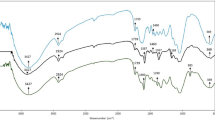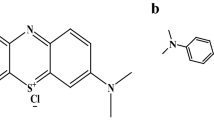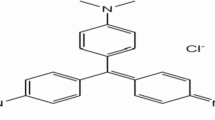Abstract
A natural biosorbent obtained from Pyracantha coccinea was modified with an anionic surfactant to facilitate its dye removal ability. Modified biosorbent was successfully employed for the decolorization of Methyl Violet (MV)-contaminated solutions. A three-variable Box–Behnken design for response surface methodology was used to examine the function of independent operating variables. Optimum pH and biosorbent amount were found to be 6.0 and 0.055 g, respectively. The effects of temperature and ionic strength on the dye removal performance of biosorbent were also investigated. A biosorption equilibrium was attained within 30 min and experimental data fitted well to the pseudo-second-order model. The Langmuir isotherm model fitted adequately to the equilibrium data. The maximum monolayer biosorption capacity of the modified biosorbent was found to be 254.88 mg g−1. Good biosorption yields were also recorded in continuous biosorption system. Ion exchange and complexation could be suggested as possible mechanisms for the biosorption. The developed modified biosorbent was regenerated up to 80.30 % by 0.005 M HCl. At real wastewater conditions, it has 86.23 ± 0.21 and 94.51 ± 1.09 % dye removal yields in batch and column systems, respectively. Modified biomaterial can be used as an effective biosorbent for the removal of MV dye from aqueous solution with high biosorption performance.







Similar content being viewed by others
References
Ahmaruzzaman M, Gupta VK (2011) Rice husk and its ash as low-cost adsorbents in water and wastewater treatment. Ind Eng Chem Res 50:13589–13613
Akar T, Divriklioglu M (2010) Biosorption applications of modified fungal biomass for decolorization of Reactive Red 2 contaminated solutions: batch and dynamic flow mode studies. Bioresour Technol 101:7271–7277
Akar T, Anilan B, Gorgulu A, Akar ST (2009a) Assessment of cationic dye biosorption characteristics of untreated and non-conventional biomass: Pyracantha coccinea berries. J Hazard Mater 168:1302–1309
Akar T, Tosun I, Kaynak Z, Kavas E, Incirkus G, Akar ST (2009b) Assessment of the biosorption characteristics of a macro-fungus for the decolorization of Acid Red 44 (AR44) dye. J Hazard Mater 171:865–871
Aksu Z, Çağatay ŞŞ (2006) Investigation of biosorption of Gemazol Turquise Blue-G reactive dye by dried Rhizopus arrhizus in batch and continuous systems. Sep Purif Technol 48:24–35
Aksu Z, Isoglu IA (2007) Use of dried sugar beet pulp for binary biosorption of Gemazol Turquoise Blue-G reactive dye and copper(II) ions: equilibrium modeling. Chem Eng J 127:177–188
Aksu Z, Çağatay ŞŞ, Gönen F (2007) Continuous fixed bed biosorption of reactive dyes by dried Rhizopus arrhizus: determination of column capacity. J Hazard Mater 143:362–371
Aksu Z, Tatli AI, Tunc O (2008) A comparative adsorption/biosorption study of Acid Blue 161: effect of temperature on equilibrium and kinetic parameter. Chem Eng J 142:23–39
Allen SJ, Gan Q, Matthews R, Johnson PA (2005) Mass transfer processes in the adsorption of basic dyes by peanut hulls. Ind Eng Chem Res 44:1942–1949
Anjaneya O, Santoshkumar M, Anand SN, Karegoudar TB (2009) Biosorption of acid violet dye from aqueous solutions using native biomass of a new isolate of Penicillium sp. Int Biodeter Biodegr 63:782–787
Aravindhan R, Rao JR, Nair BU (2007) Removal of basic yellow dye from aqueous solution by sorption on green alga Caulerpa scalpelliformis. J Hazard Mater 142:68–76
Asgher M, Bhatti HN (2012) Evaluation of thermodynamics and effect of chemical treatments on sorption potential of Citrus waste biomass for removal of anionic dyes from aqueous solutions. Ecol Eng 38:79–85
Barron-Zambrano J, Szygula A, Ruiz M, Sastre AM, Guibal E (2010) Biosorption of reactive black 5 from aqueous solutions by chitosan: column studies. J Environ Manag 91:2669–2675
Belala Z, Jeguirim M, Belhachemi M, Addoun F, Trouvé G (2011) Biosorption of basic dye from aqueous solutions by date stones and palm-trees waste: kinetic, equilibrium and thermodynamic studies. Desalination 271:80–87
Bhatnagar A, Vilar VJP, Botelho CMS, Boaventura RAR (2010) Coconut-based biosorbents for water treatment—a review of the recent literature. Adv Colloid Interface Sci 160:1–15
Bingol A, Aslan A, Cakici A (2009) Biosorption of chromate anions from aqueous solution by a cationic surfactant-modified lichen (Cladonia rangiformis (L.)). J Hazard Mater 161:747–752
Crini G (2008) Kinetic and equilibrium studies on the removal of cationic dyes from aqueous solution by adsorption onto a cyclodextrin polymer. Dyes Pigments 77:415–426
Daneshvar E, Kousha M, Sohrabi MS, Khataee A, Converti A (2012a) Biosorption of three acid dyes by the brown macroalga Stoechospermum marginatum: isotherm, kinetic and thermodynamic studies. Chem Eng J 195:297–306
Daneshvar E, Kousha M, Sohrabi MS, Khataee A, Converti A (2012b) Biosorption of three acid dyes by the brown macroalga Stoechospermum marginatum: isotherm, kinetic and thermodynamic studies. Chem Eng J 195–196:297–306
Dubinin M, Radushkevich L (1947) Equation of the characteristic curve of activated charcoal. Chem Zentr 1:875–890
Fan H, Yang JS, Gao TG, Yuan HL (2012) Removal of a low-molecular basic dye (Azure Blue) from aqueous solutions by a native biomass of a newly isolated Cladosporium sp.: kinetics, equilibrium and biosorption simulation. J Taiwan Inst Chem Eng 43:386–392
Farah JY, El-Gendy NS, Farahat LA (2007) Biosorption of Astrazone Blue basic dye from an aqueous solution using dried biomass of Baker's yeast. J Hazard Mater 148:402–408
Fernandez ME, Nunell GV, Bonelli PR, Cukierman AL (2012) Batch and dynamic biosorption of basic dyes from binary solutions by alkaline-treated cypress cone chips. Bioresour Technol 106:55–62
Freundlich H (1906) Über die absorption in lösungen. Universität Leipzig, 98p
Hall KR, Eagleton LC, Acrivos A, Vermeulen T (1966) Pore- and solid-diffusion kinetics in fixed-bed adsorption under constant pattern conditions. Ind Eng Chem Fundam 5:212–223
Hameed BH (2008) Equilibrium and kinetic studies of methyl violet sorption by agricultural waste. J Hazard Mater 154:204–212
Han R, Wang Y, Yu W, Zou W, Shi J, Liu H (2007) Biosorption of methylene blue from aqueous solution by rice husk in a fixed-bed column. J Hazard Mater 141:713–718
Ho Y-S (2006) Review of second-order models for adsorption systems. J Hazard Mater 136:681–689
Kaushik P, Malik A (2009) Fungal dye decolourization: recent advances and future potential. Environ Int 35:127–141
Khambhaty Y, Mody K, Basha S (2012) Efficient removal of Brilliant Blue G (BBG) from aqueous solutions by marine Aspergillus wentii: kinetics, equilibrium and process design. Ecol Eng 41:74–83
Kiran B, Kaushik A, Kaushik CP (2007) Response surface methodological approach for optimizing removal of Cr(VI) from aqueous solution using immobilized cyanobacterium. Chem Eng J 126:147–153
Kumar R, Ahmad R (2011) Biosorption of hazardous crystal violet dye from aqueous solution onto treated ginger waste (TGW). Desalination 265:112–118
Kwon OJ, Yoon DH, Kim JJ (2008) Silicon-based miniaturized reformer with methanol catalytic burner. Chem Eng J 140:466–472
Lagergren S (1989) Zur theorie der sogenannten adsorption gelöster stoffe. Kungliga Svenska Vetenskapsakademiens Handlingar 24:1–39
Langmuir I (1918) The adsorption of gases on plane surfaces of glass, mica and platinum. J Am Chem Soc 40:1361–1403
Li P, Su Y-J, Wang Y, Liu B, Sun L-M (2010) Bioadsorption of methyl violet from aqueous solution onto Pu-erh tea powder. J Hazard Mater 179:43–48
Liu L, Wan Y, Xie Y, Zhai R, Zhang B, Liu J (2012) The removal of dye from aqueous solution using alginate-halloysite nanotube beads. Chem Eng J 187:210–216
Loukidou MX, Matis KA, Zouboulis AI, Liakopoulou-Kyriakidou M (2003) Removal of As(V) from wastewaters by chemically modified fungal biomass. Water Res 37:4544–4552
Mall ID, Srivastava VC, Agarwal NK (2006) Removal of Orange-G and Methyl Violet dyes by adsorption onto bagasse fly ash—kinetic study and equilibrium isotherm analyses. Dyes Pigments 69:210–223
Mona S, Kaushik A, Kaushik CP (2011) Biosorption of reactive dye by waste biomass of Nostoc linckia. Ecol Eng 37:1589–1594
Montgomery DC (2005) Design and analysis of experiments, 6th edn. Wiley, New Jersey
Nanseu-Njiki CP, Dedzo GK, Ngameni E (2010) Study of the removal of paraquat from aqueous solution by biosorption onto Ayous (Triplochiton schleroxylon) sawdust. J Hazard Mater 179:63–71
Nermeen A, El-Sersy (2007) Bioremediation of methylene blue by Bacillus thuringiensis 4 G1: application of statistical designs and surface plots for optimization. Biotechnology 6:34–39
Oei BC, Ibrahim S, Wang SB, Ang HM (2009) Surfactant modified barley straw for removal of acid and reactive dyes from aqueous solution. Bioresour Technol 100:4292–4295
Ofomaja AE (2008) Kinetic study and sorption mechanism of methylene blue and methyl violet onto mansonia (Mansonia altissima) wood sawdust. Chem Eng J 143:85–95
Ofomaja AE, Ho Y-S (2008) Effect of temperatures and pH on methyl violet biosorption by Mansonia wood sawdust. Bioresour Technol 99:5411–5417
Ofomaja AE, Ukpebor EE, Uzoekwe SA (2011) Biosorption of Methyl violet onto palm kernel fiber: diffusion studies and multistage process design to minimize biosorbent mass and contact time. Biomass Bioenergy 35:4112–4123
Özcan AS, Özcan A, Tunali S, Akar T, Kiran I, Gedikbey T (2007) Adsorption potential of lead(II) ions from aqueous solutions onto Capsicum annuum seeds. Sep Sci Technol 42:137–151
Pouralinazar F, Yunus MAC, Zahedi G (2012) Pressurized liquid extraction of Orthosiphon stamineus oil: experimental and modeling studies. J Supercrit Fluid 62:88–95
Pratibha R, Malar P, Rajapriya T, Balapoornima S, Ponnusami V (2010) Statistical and equilibrium studies on enhancing biosorption capacity of Saccharomyces cerevisiae through acid treatment. Desalination 264:102–107
Saha PD, Chakraborty S, Chowdhury S (2012) Batch and continuous (fixed-bed column) biosorption of crystal violet by Artocarpus heterophyllus (jackfruit) leaf powder. Colloid Surf B 92:262–270
Saleem M, Pirzada T, Qadeer R (2005) Sorption of some azo-dyes on wool fiber from aqueous solutions. Colloid Surf A 260:183–188
Senturk HB, Ozdes D, Duran C (2010) Biosorption of Rhodamine 6G from aqueous solutions onto almond shell (Prunus dulcis) as a low cost biosorbent. Desalination 252:81–87
Sharma P, Singh L, Dilbaghi N (2009) Optimization of process variables for decolorization of Disperse Yellow 211 by Bacillus subtilis using Box–Behnken design. J Hazard Mater 164:1024–1029
Tian Y, Ji C, Zhao M, Xu M, Zhang Y, Wang R (2010) Preparation and characterization of baker's yeast modified by nano-Fe3O4: application of biosorption of methyl violet in aqueous solution. Chem Eng J 165:474–481
Tunali Akar S, Gorgulu A, Akar T, Celik S (2011) Decolorization of Reactive Blue 49 contaminated solutions by Capsicum annuum seeds: batch and continuous mode biosorption applications. Chem Eng J 168:125–133
Tunali S, Ozcan A, Kaynak Z, Ozcan AS, Akar T (2007) Utilization of the Phaseolus vulgaris L. waste biomass for decolorization of the textile dye Acid Red 57: determination of equilibrium, kinetic and thermodynamic parameters. J. Environ. Sci. Health A 42:591–600
Vijayaraghavan K, Lee MW, Yun Y-S (2008a) A new approach to study the decolorization of complex reactive dye bath effluent by biosorption technique. Bioresour Technol 99:5778–5785
Vijayaraghavan K, Won SW, Mao J, Yun YS (2008b) Chemical modification of Corynebacterium glutamicum to improve methylene blue biosorption. Chem Eng J 145:1–6
Walker GM, Weatherley LR (2000) Biodegradation and biosorption of acid anthraquinone dye. Environ Pollut 108:219–223
Wang BE, Hu YY, Xie L, Peng K (2008) Biosorption behavior of azo dye by inactive CMC immobilized Aspergillus fumigatus beads. Bioresour Technol 99:794–800
Weber WJ Jr, Morriss JC (1963) Kinetics of adsorption on carbon from solution. J Sanit Eng Div Am Soc Civ Eng 89:31–39
Yeddou-Mezenner N (2010) Kinetics and mechanism of dye biosorption onto an untreated antibiotic waste. Desalination 262:251–259
Author information
Authors and Affiliations
Corresponding author
Additional information
Responsible editor: Bingcai Pan
Appendix
Appendix
Kinetic and isotherm model equations
The pseudo-first-order equation;
The pseudo-second-order rate equation;
The intraparticle diffusion equation;
which k 1 is rate constant of pseudo-first-order biosorption (min−1), k 2 is the equilibrium rate constant of pseudo-second-order biosorption (g mg−1 min−1), q e and q t are biosorption capacity at equilibrium and at time t (mg g−1), respectively, h is the initial biosorption rate (mg g min−1), C is the intercept (mg g−1), and k p is the intraparticle diffusion rate constant (mg g−1 min−1/2).
Freundlich isotherm equation;
Langmuir isotherm model;
D − R isotherm model;
where q e (mol g−1) and C e (mol L−1) are the amount of biosorbed dye per unit weight of biosorbent and unbiosorbed dye concentration in solution at equilibrium, respectively, K F (L g−1) and n (dimensionless) are Freundlich constants, q max is the maximum monolayer biosorption capacity (mol g−1), K L is Langmuir constant related to the energy of biosorption (L mol−1), R L is separation factor, C o is the initial solute concentration (mol L−1), q m is the biosorption capacity (mol g−1), β is the activity coefficient related to the biosorption energy, and E (kJ mol−1) is the mean free energy.
Rights and permissions
About this article
Cite this article
Akar, S.T., Sayin, F., Turkyilmaz, S. et al. Multivariate optimization of the decolorization process by surface modified biomaterial: Box–Behnken design and mechanism analysis. Environ Sci Pollut Res 21, 13055–13068 (2014). https://doi.org/10.1007/s11356-014-3245-5
Received:
Accepted:
Published:
Issue Date:
DOI: https://doi.org/10.1007/s11356-014-3245-5




